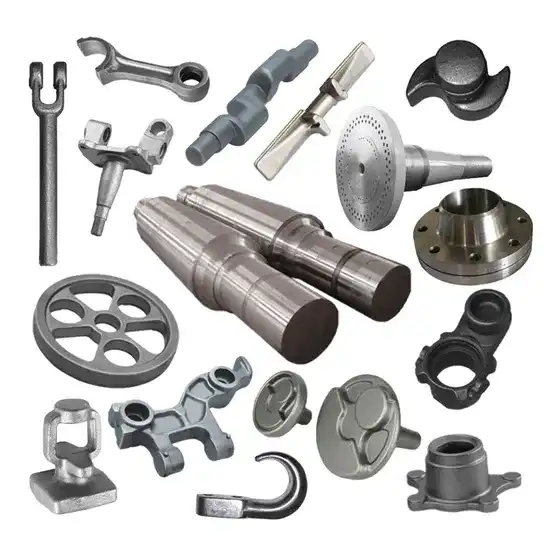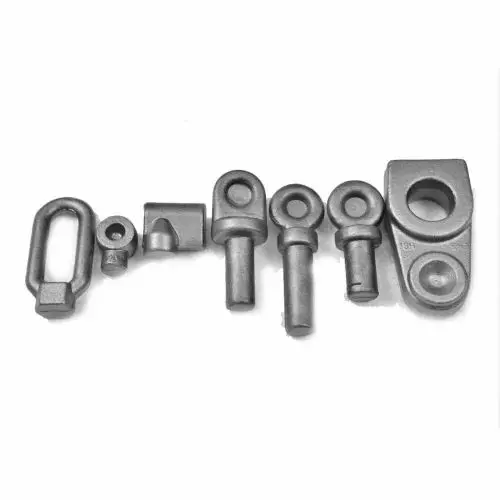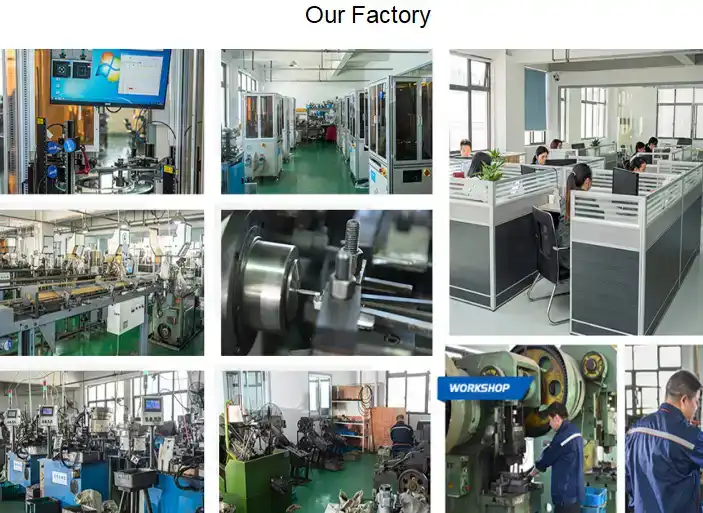How Does Heat Treatment Enhance the Quality of Forged Steel Mechanical Parts?
2025-08-07 10:06:28
Heat treatment represents one of the most critical processes in manufacturing forged steel mechanical parts, fundamentally transforming their mechanical properties and performance characteristics. This controlled thermal process involves heating, holding, and cooling steel components under specific conditions to achieve desired microstructural changes that directly impact strength, hardness, toughness, and durability. For forged steel mechanical parts used in demanding industrial applications, heat treatment serves as the bridge between raw forged components and precision-engineered solutions that meet stringent performance requirements across automotive, aerospace, oil and gas, and heavy machinery sectors.

The Science Behind Heat Treatment in Forged Steel Components
Microstructural Transformation During Heat Treatment
The fundamental principle of heat treatment lies in the controlled manipulation of steel's microstructure through precise temperature and time management. When forged steel mechanical parts undergo heat treatment, the carbon atoms within the steel matrix experience diffusion and redistribution, leading to the formation of different crystalline phases that determine the final mechanical properties. The austenite phase, formed at elevated temperatures typically between 850-950°C, serves as the foundation for subsequent transformations. During this phase, carbon atoms dissolve uniformly throughout the iron matrix, creating a homogeneous structure that can be further modified through controlled cooling processes. The transformation from austenite to martensite, bainite, or pearlite depends on the cooling rate and temperature control, with each phase contributing unique characteristics to the final forged steel mechanical parts. This microstructural control is particularly crucial for components manufactured by companies like Qingdao RUIRUI Machinery Co., LTD, where precision-engineered solutions demand consistent quality and performance across varying applications.
Thermal Cycling and Grain Structure Refinement
Heat treatment processes fundamentally alter the grain structure of forged steel mechanical parts through controlled thermal cycling, which involves multiple heating and cooling phases designed to optimize material properties. The initial forging process creates a coarse grain structure that, while providing good formability, may not deliver the optimal mechanical properties required for high-performance applications. Through normalizing heat treatment, forged steel mechanical parts are heated to approximately 50-100°C above the upper critical temperature and then air-cooled, resulting in a refined grain structure with improved uniformity and mechanical properties. This process eliminates internal stresses developed during forging and creates a more homogeneous microstructure throughout the component. The refined grain structure enhances both strength and toughness, making the forged steel mechanical parts more suitable for demanding applications in automotive engines, transmission systems, and heavy machinery components. Advanced facilities like those operated by Qingdao RUIRUI Machinery Co., LTD utilize sophisticated thermal cycling equipment to ensure precise temperature control and consistent results across their comprehensive range of forged steel mechanical parts.
Phase Transformation Control and Property Enhancement
The controlled manipulation of phase transformations during heat treatment enables manufacturers to tailor the properties of forged steel mechanical parts to meet specific application requirements. The relationship between cooling rate and final microstructure is critical, as it determines whether the steel will exhibit high hardness with reduced toughness or moderate hardness with enhanced ductility. Isothermal transformation diagrams, commonly known as TTT (Time-Temperature-Transformation) curves, provide the roadmap for achieving desired microstructural compositions in forged steel mechanical parts. By carefully controlling the cooling process, manufacturers can achieve bainitic structures that offer excellent combinations of strength and toughness, or martensitic structures that provide maximum hardness for wear-resistant applications. This level of control is essential for forged steel mechanical parts used in critical applications such as turbine blades, valve bodies, and connecting rods, where failure can result in catastrophic consequences. The expertise developed over 15 years by companies like Qingdao RUIRUI Machinery Co., LTD in forging technology enables them to optimize phase transformation processes for their wide range of forged steel mechanical parts, ensuring consistent quality and performance across different material grades and component geometries.
Heat Treatment Processes and Their Impact on Mechanical Properties
Normalizing Process for Stress Relief and Uniformity
Normalizing serves as a fundamental heat treatment process that significantly enhances the quality of forged steel mechanical parts by eliminating internal stresses and creating uniform microstructures throughout the component. This process involves heating the forged steel mechanical parts to approximately 50-100°C above the upper critical temperature, maintaining this temperature for sufficient time to ensure complete austenitization, followed by air cooling to room temperature. The normalizing process is particularly beneficial for forged steel mechanical parts that have experienced non-uniform cooling during the initial forging operation, which can result in residual stresses and microstructural heterogeneity. During normalizing, the austenite grains grow uniformly, and the subsequent air cooling produces a refined pearlitic structure with improved mechanical properties. This process is essential for forged steel mechanical parts used in applications where dimensional stability and consistent mechanical properties are critical, such as gears, sprockets, and shafts. The normalized microstructure provides an excellent balance of strength, toughness, and machinability, making it suitable for subsequent manufacturing operations and final applications across automotive, marine, and heavy machinery industries.
Quenching and Tempering for Optimal Strength-Toughness Balance
The quenching and tempering process represents one of the most effective heat treatment methods for achieving optimal strength-toughness balance in forged steel mechanical parts. Quenching involves rapid cooling from the austenitizing temperature using water, oil, or polymer-based quenchants, resulting in the formation of martensite, a hard but brittle phase. The rapid cooling rate prevents the diffusion of carbon atoms, trapping them in a supersaturated solution that creates high internal stresses and maximum hardness. However, the as-quenched condition is typically too brittle for most applications, necessitating the tempering process. Tempering involves reheating the quenched forged steel mechanical parts to temperatures between 150-650°C, allowing controlled diffusion of carbon atoms and stress relief while maintaining much of the strength gained during quenching. This process enables manufacturers to achieve specific combinations of hardness, strength, and toughness tailored to the application requirements of forged steel mechanical parts. The precise control of tempering temperature and time allows for fine-tuning of mechanical properties, making it possible to optimize performance for specific applications such as connecting rods in automotive engines, flanges in oil and gas equipment, or landing gear components in aerospace applications.
Annealing for Enhanced Machinability and Formability
Annealing represents a crucial heat treatment process that significantly improves the machinability and formability of forged steel mechanical parts while providing stress relief and microstructural homogenization. This process involves heating the forged steel mechanical parts to temperatures slightly below or above the critical temperature, followed by extremely slow cooling, typically in a furnace or buried in insulating materials. The slow cooling rate allows for the formation of a coarse pearlitic structure with spheroidized carbides, which provides excellent machinability characteristics essential for subsequent manufacturing operations. For forged steel mechanical parts that require extensive machining operations, annealing is often performed after initial forging to reduce hardness and improve chip formation during cutting operations. The process also eliminates work hardening effects that may have occurred during forging, restoring the material's ability to undergo further deformation if required. This is particularly important for complex-shaped forged steel mechanical parts that may require additional forming operations or extensive machining to achieve final dimensions. The annealed condition also provides excellent starting material for subsequent heat treatment processes, ensuring uniform response to hardening treatments and consistent final properties throughout the component geometry.

Advanced Heat Treatment Techniques for Superior Performance
Controlled Atmosphere Heat Treatment for Surface Quality
Advanced controlled atmosphere heat treatment techniques have revolutionized the quality enhancement of forged steel mechanical parts by providing precise control over surface chemistry and preventing oxidation and decarburization during thermal processing. Traditional heat treatment in air atmospheres often results in surface oxidation and carbon depletion near the surface, which can significantly compromise the mechanical properties and fatigue resistance of forged steel mechanical parts. Controlled atmosphere furnaces utilize carefully balanced gas mixtures, typically containing nitrogen, hydrogen, and carbon monoxide, to create neutral or slightly carburizing environments that protect the surface integrity during heat treatment. This technology is particularly crucial for forged steel mechanical parts used in high-stress applications such as automotive transmissions, aerospace components, and power generation equipment, where surface quality directly impacts performance and service life. The controlled atmosphere process ensures that the beneficial effects of heat treatment extend throughout the entire cross-section of forged steel mechanical parts, including the critical surface layers that experience the highest stresses during service. Companies like Qingdao RUIRUI Machinery Co., LTD have invested in advanced controlled atmosphere heat treatment systems to ensure their forged steel mechanical parts meet the stringent surface quality requirements of modern industrial applications.
Vacuum Heat Treatment for Premium Applications
Vacuum heat treatment represents the pinnacle of thermal processing technology for forged steel mechanical parts requiring the highest levels of cleanliness, surface quality, and mechanical property consistency. This advanced process is conducted in vacuum chambers where the atmospheric pressure is reduced to extremely low levels, typically below 10⁻³ torr, eliminating the presence of oxygen and other reactive gases that can cause surface contamination or property degradation. Vacuum heat treatment is particularly beneficial for forged steel mechanical parts manufactured from premium alloy steels or those destined for critical applications in aerospace, medical devices, or high-performance automotive components. The absence of atmospheric contamination allows for precise control of surface chemistry and prevents the formation of oxides or other detrimental surface compounds that can act as stress concentrators or fatigue initiation sites. Additionally, vacuum heat treatment enables the use of specialized cooling gases such as nitrogen or argon for controlled cooling rates, providing manufacturers with unprecedented control over the final microstructure and mechanical properties of forged steel mechanical parts. This technology is essential for achieving the tight tolerances and consistent quality demanded by industries where component failure can have catastrophic consequences.
Induction Heat Treatment for Selective Hardening
Induction heat treatment technology offers unprecedented precision in selectively enhancing specific regions of forged steel mechanical parts while leaving other areas unaffected, enabling the creation of components with tailored property distributions. This process utilizes electromagnetic induction to generate heat directly within the steel component, allowing for extremely rapid heating and precise temperature control in localized areas. For forged steel mechanical parts such as gears, shafts, and connecting rods, induction heat treatment can be used to selectively harden wear surfaces while maintaining toughness in the core material, optimizing overall component performance. The rapid heating and cooling cycles achievable with induction systems result in fine-grained microstructures with superior mechanical properties compared to conventional heat treatment methods. This technology is particularly valuable for large forged steel mechanical parts where uniform heat treatment would be impractical or economically unfeasible. The precise control offered by induction heat treatment systems allows manufacturers to achieve specific hardness patterns, create smooth transitions between hardened and unhardened regions, and minimize distortion during processing. Advanced induction heat treatment capabilities enable companies to produce forged steel mechanical parts with complex property profiles that would be impossible to achieve through conventional heat treatment methods, opening new possibilities for component design and performance optimization.

Conclusion
Heat treatment serves as the cornerstone technology for transforming forged steel mechanical parts from basic forged components into precision-engineered solutions that meet the demanding requirements of modern industrial applications. Through controlled thermal processes including normalizing, quenching and tempering, and annealing, manufacturers can achieve optimal combinations of strength, toughness, and performance characteristics tailored to specific applications. The integration of advanced techniques such as controlled atmosphere and vacuum heat treatment further enhances quality and consistency, ensuring forged steel mechanical parts deliver superior performance across automotive, aerospace, oil and gas, and heavy machinery sectors.
At Qingdao RUIRUI Machinery Co., LTD, we combine over 15 years of forging expertise with state-of-the-art heat treatment capabilities to deliver exceptional forged steel mechanical parts that exceed industry standards. Our comprehensive manufacturing approach, from initial design through final heat treatment, ensures consistent quality and performance across our extensive product range. With complete equipment facilities, an efficient R&D team, and advanced processing technologies including CNC machining, laser cutting, and welding, we provide comprehensive solutions for your most demanding applications.
Our commitment to quality is demonstrated through ISO 9001, ISO 14001, and OHSAS 18001 certifications, while our global reach extends to over 80 countries including Spain, the UK, Europe, America, and Australia. We specialize in working with various materials including mild steel, stainless steel, aluminum alloys, copper, and brass, providing customized processing services that ensure each material receives optimal treatment for maximum performance.
Whether you need complex parts manufacturing, fine processing technology, or comprehensive OEM support, RUIRUI provides the best services and solutions through our extensive experience and efficient production capacity. Our progressive stamping, deep drawing, anodizing, polishing, powder coating, and electrophoresis capabilities ensure complete processing solutions under one roof.
Ready to enhance your projects with premium forged steel mechanical parts? Contact our experienced team today to discuss your specific requirements and discover how our advanced heat treatment capabilities can optimize your component performance. We welcome new and old customers worldwide to visit and collaborate with us for long-term success.
For technical inquiries, quotations, or to discuss your specific forged steel mechanical parts requirements, please reach out to us at: info@qdkshd.com
References
1. Totten, G.E., & Howes, M.A. (2021). Heat Treatment of Steel: Principles and Applications in Forged Components. ASM International, Materials Park, Ohio.
2. Brooks, C.R., & Choudhury, A. (2019). Microstructural Evolution in Forged Steel Parts During Heat Treatment Processes. Journal of Materials Engineering and Performance, 28(4), 2156-2168.
3. Krauss, G. (2020). Steels: Processing, Structure, and Performance in Forged Mechanical Components. Second Edition, ASM International, Materials Park, Ohio.
4. Bhadeshia, H.K.D.H., & Honeycombe, R.W.K. (2018). Heat Treatment and Phase Transformations in Forged Steel Applications. Fourth Edition, Butterworth-Heinemann, Oxford, UK.
Send Inquiry
You may like
